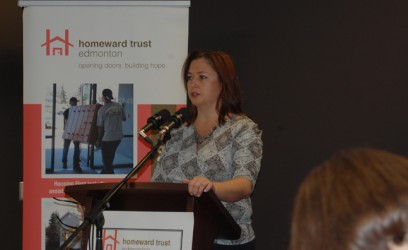Article Origin
Volume
Issue
Year
A point-in-time count of homelessness in Alberta’s seven largest municipalities shows a bleak picture of over-representation for the urban Aboriginal population.
But Fort McKay First Nation Chief Jim Boucher takes hope from Premier Jim Prentice’s first Speech from the Throne.
“Aboriginal people have important contributions to make to our cities, but sometimes the transition from rural or isolated communities to urban centres can be challenging. Your government will work directly with First Nations, Métis and Inuit communities along with urban Aboriginal organizations and federal and municipal governments to develop and support initiatives to ease transitions to urban centres and into new opportunities,” said Prentice.
Boucher is impressed that Prentice has prioritized the issue.
“There is a huge problem I think in the urban centres of this country and we need to find a way to address those issues as related to poverty and crime in the urban centres. But I think on the other hand, we need to find a way to build up our people so they’re able to live a good life style,” he said.
In a single week in mid-October, Medicine Hat, Calgary, Lethbridge, Red Deer, Edmonton, the Municipality of Wood Buffalo, and Grande Prairie did counts of the homeless. The result was cause for concern for Aboriginal people living in the cities.
Aboriginal homelessness ranged from 24 per cent in Red Deer (the lowest figure) to a high of 67 per cent in Lethbridge. Red Deer’s overall Aboriginal population is 5.2 per cent while 4.3 per cent of Lethbridge’s overall population is Aboriginal. In Edmonton, the Canadian city with the second largest urban Aboriginal population (at 5.4 per cent), Aboriginal people accounted for 40 per cent of the homeless.
Susan McGee, both executive director for Homeward Trust Edmonton and chair for 7 Cities of Alberta, says homelessness is not the only area in which Aboriginal people are heavily over-represented.
“Aboriginal community members have been exposed historically to the residential school system, they’ve had very disruptive impacts from the residential school system in their home communities and individually. We know that’s a contributing factor,” she said. “For those that come, that have experienced that trauma, that don’t have a support (system), a lot of those historical issues have contributed to their situation.”
Racism, McGee also notes, is another reason why Aboriginal people have difficulty finding shelter.
McGee also finds Prentice’s words encouraging.
“It’s very significant. The premier has made a commitment. He’s the minister of Aboriginal relations and I think that speaks volumes to his commitment to the issue. So that’s something that signals not only to the resourcing and implementation, but it signals to the province as a whole, that this is something that is important to us,” she said.
Overall, the provincial count of the homeless population saw a decrease of 16 per cent compared to 2008, when efforts began to end homelessness. However, neither Medicine Hat nor Red Deer has a 2008 comparative figure as neither counted then.
The point-in-time count was part of an initiative led by the 7 Cities in collaboration with the Canadian Observatory on Homelessness to develop a harmonized approach to homeless counts nationally. This is the first time an aligned count has taken place in Alberta.
A detailed report for each community is expected early in the new year.
Photo caption: Homeward Trust Edmonton Executive Director Susan McGee, as well as chair of 7 Cities of Alberta, released preliminary results of the point-in-time homeless count that was carried out in October.
- 1191 views

